See NewZealand.com's Key Facts and FourCorners.co.nz New Zealand Facts for general visitor information about language, driving, time differences and so forth. Information below is tramping-specific.
Climate
Seasons are reversed compared with the northern hemisphere, so summer is December-February and winter is June-August. The north of the North Island is warmest, while the south of the South Island is coolest. Temperatures are typically 5-15 degrees Celsius in winter and 10-25 degrees Celsius in summer. In the mountains, rain and snow can be expected at any time of year. Weather conditions are highly changeable and unpredictable. You should always pack rainwear and layers of thermal clothing that can be worn or removed as required. Mid-summer tramping can be very hot, even in the mountains. Autumn and Spring are probably the most pleasant seasons for tramping.
Animals
New Zealand is a land of birds. Historically, the only land mammals were a few bats. Many birds became flightless. New Zealand inherited a bizarre variety of birds. Today, introduced cats, dogs, stoats and rats pose a grave threat to New Zealand bird species with many having already become extinct. There are few potentially dangerous animals in New Zealand.
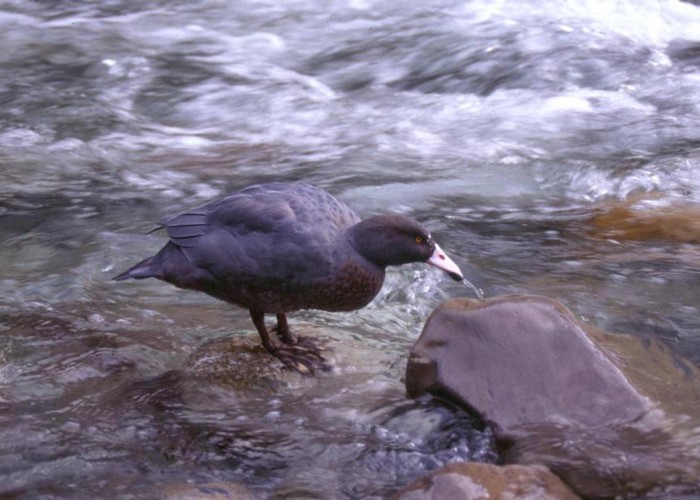
Geography
New Zealand is a chain of three main islands about the size of the United Kingdom or Japan. From north to south, these islands are known as the North Island, the South Island and Stewart Island or Rakiura. The national population is just over 4 million people.
North Island
Most people live in the north of the North Island around Auckland. The national capital is Wellington, at the bottom of the North Island. This island is dominated by farmland, but features a distinctive "volcanic plateau" at its heart. This area includes the Ruapehu, Tongariro, and Ngauruhoe volcanoes (strictly speaking, Ngauruhoe is an active cone of the Tongariro Volcano). The massive lake at the centre of the North Island, Taupo, is actually another massive volcano. It last erupted in 182AD, causing great devastation. Mount Egmont / Taranaki is another striking volcano to the southwest.
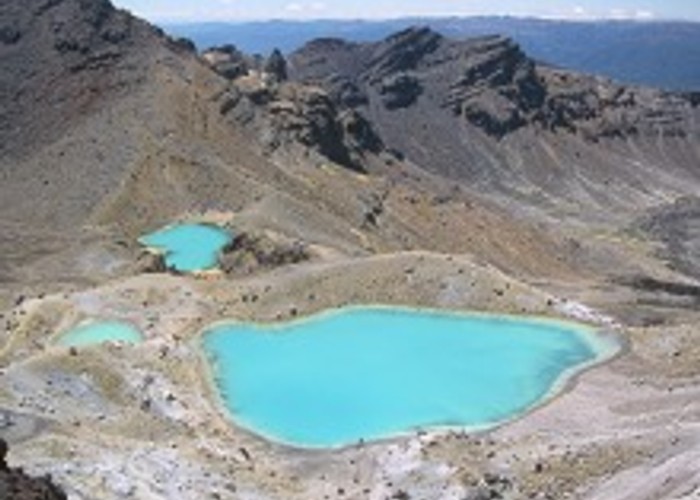
South Island
The South Island is dominated by the Southern Alps, a young mountain range that runs most of the length of the island. This range includes New Zealand's highest mountain, Aoraki / Mount Cook (3754m). There are two key cities in the South Island: Christchurch about midway down the east coast and Dunedin near the bottom of the east coast. The town of Queenstown, inland from Dunedin, is also a good base for outdoor adventure.
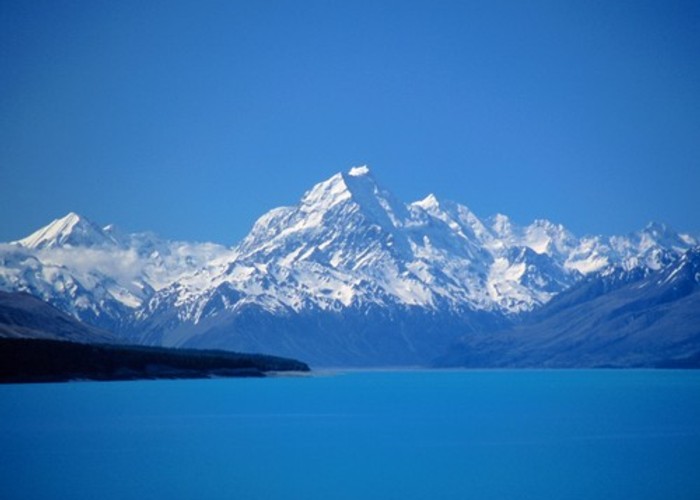
While lacking the spectacular volcanism of the North Island, the South Island offers the most variety for trampers. The West Coast is relatively wet and rainy, creating rich, diverse, tangled forests, compared with drier beech forests to the east. The southwest corner of the island is dominated by glacier-carved valleys and is particularly wet and inaccessible. Many of the most famous tracks are in this area, including the Routeburn, Milford and Kepler Tracks. The northern tip of the island offers palm beaches, karst landscapes, and ancient grassland peneplains.
There are three passes over the Southern Alps. Each offers a variety of tramping tracks and routes. Furthest south is Haast Pass which leads from near Wanaka through to the West Coast. Tracks in this area are mostly challenging wilderness experiences. Further north is the raw landscape of Arthur's Pass. Arthur's Pass National Park contains a large selection of tracks, mostly maintained to a basic level. Being just a few hours from Christchurch, the park is a good landscape for competent tramping parties to explore. Further north still is Lewis Pass, a beautiful drive through tall beech forests. There are many easier tracks in this area as well as some easier "tops" routes.
Public land
New Zealand has 14 national parks, each preserving outstanding and distinctive landscapes. Tongariro was our first national park and is also a World Heritage Area. In the southwest of the South Island, Fiordland, Mount Aspiring, Westland, and Aoraki/Mount Cook National Parks combine to form another World Heritage Area. Entry to national parks is free and uncontrolled. Many activities are prohibited in national parks such as off-road vehicles (including mountain bikes) and unlicenced commercial activities (including guiding parties).
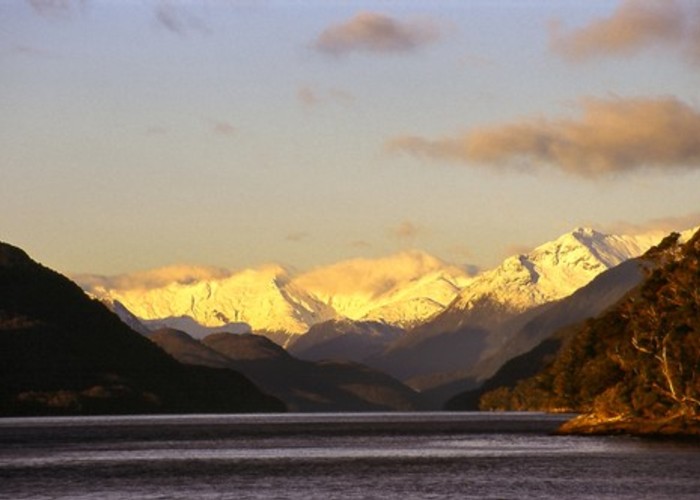
Supplementing the national parks are a variety of other reserves, grasslands parks, and forest parks. These areas are often less tightly controlled (horse trekking and mountain biking may be allowed, for example) and may be less distinctive.
Most public land areas are freely accessible. This means you don't need to pay to go tramping, except for accommodation, unless you choose a private or guided walk.
DOC
Public lands are managed by the Department of Conservation (DOC). DOC visitor centres are found throughout the country in towns and national parks. DOC can provide information and advice on tracks, weather, and current conditions.
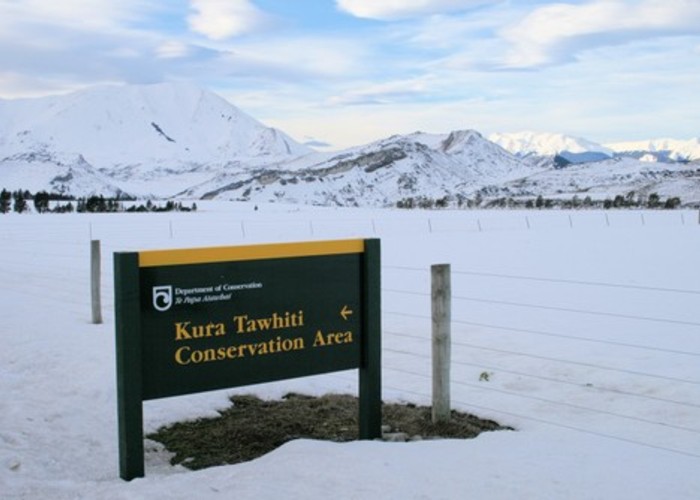
New Zealand has a well-established system of basic backcountry huts available for public use and administered by DOC. Most of these are available on a first-come first served basis, although hut users must be prepared to share with all later arrivals. Most huts cannot be booked, although you are expected to pay for use in advance. You can do this by purchasing hut tickets or an annual hut pass. Hut tickets and passes apply for most huts but not for any Great Walks huts (except in the off-season). Great Walks huts require Great Walks passes which are also purchased in advance but are specific to a particular Great Walk. Camping on Great Walks also requires a Great Walks pass.
Safety
Rivers
As there is such a short distance between mountains and sea, Rivers in New Zealand rise quickly during rain and can become impassable. Fortunately, they also fall quickly so be prepared to wait it out. The best river crossing technique is to form a line of people with the strongest person upstream, place your arms between your neighbours' backs and packs and grab the straps on the far side. As a chain, aim to cross diagonally downstram, moving with the current. If you cannot see the bottom or if you feel rocks moving past your feet, retreat back to the river bank. So many people have died on drowning in New Zealand rivers that it was known as "the New Zealand Death" in colonial times.
Hypothermia
Hypothermia is another serious hazard. It occurs when your core body temperature (as opposed to your fingers and toes) drops. It can be caused by exhaustion, getting wet, and having inadequate warm clothing. Symptoms include sluggishness and confusion. The victim may not complain of feeling cold and may not shiver. If you are cold, you should not push on because you are "almost there". You should change your clothing (borrow some if necessary). A woollen hat is critical, and a raincoat can help by stopping wind. If you think a party member is hypothermic, your group must deal with that before attempting to continue to your destination. Ensure the person is not wet and is well wrapped up and give them carbohydrate-rich food. If they appear to be severely hypothermic, plan to camp on the spot. The classic treatment is two people in one sleeping bag. Body warmth is the best way of warming someone gently. Do not give hot drinks. If you are trapped in rain, packs, pack liners and survival bags can be used to keep the rain off. Remember that down sleeping bags are ineffective if wet.
Getting lost
If you become separated from your party and lost, the best thing to do is stop moving. They will come to find you but won't be able to if you move around. Set up a camp and keep yourself warm. Search and rescue operations divide landscape up into a grid and work through it systematically. Once again, if you move around they may not find you.
Leave your detailed trip intentions with a trusted contact. Be sure to let them know when you return. Forms to help you do this are available at the AdventureSmart website. Leave notes in hut books, even if you do not stay in the hut. If you are travelling away from common tracks, consider mountain radios and personal locator beacons.
Wildlife
There are no bears, snakes, scorpions, or major spiders to content with. There is one poisonous spider called the katipo, but it inhabits unaltered sand dune areas and is very rare. Seals and sea lions can be found around the coastline and can become aggressive if cornered. In particular, sea lions are not afraid of humans and will chase you if you approach them too closely. Generally, keep a distance of 10 metres. Falcons are becoming more common in forested river landscapes. They will dive at you if you inadvertantly approach their nest. If you do not keep your head down they may strike it. Generally, all native wildlife in New Zealand is protected and may not be harmed or interfered with.
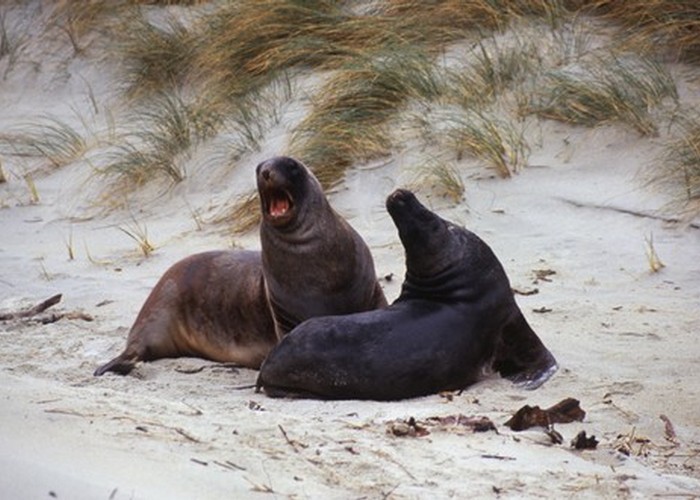
One notable animal is the sandfly, a small black biting fly. It does not carry disease but it inflicts an annoying bite. Insect repellant is essential in some areas, particularly the West Coast of the South Island. Sandflies are active during daylight, and particularly around wet, grassy areas on overcast days. Sandflies will not bother you while you are tramping as they cannot catch you, but they will find you as soon as you stop! You won't encounter many mosquitoes in New Zealand, and they do not carry disease.
Water
Giardia is a nasty disease that has been detected in some New Zealand rivers. However, reports of people suffering from Giardia seem to be very rare. A general rule is that water in side-creeks draining forested hillsides should be fine. Remember you are far more likely to suffer symptoms due to dehydration than due to water-borne diseases. It is generally not necessary to filter or treat water, but you may like to do so.
Note that putting your head under water in a thermal pool anywhere carries a a risk of amoebic meningitis, a very rare but very deadly disease. If you do this by accident, blow your nose firmly and thoroughly.
Getting prepared
Larger towns and cities all have outdoor stores that can sell you packs, tents, sleeping bags, cookers, boots, thermal clothing, and other gear. The best maps are the 1:50000 topographic maps published by Land Information New Zealand and the 1:50000 recreational maps published by TerraLink. These are available from outdoor stores, large bookstores, DOC visitor centres, and from map shops. DOC produce Park Maps covering both national parks and major tracks. These are useful if you are staying on well-marked tracks or for planning purposes. Hut tickets, annual passes and Great Walks passes are available from DOC visitor centres. Here is a very basic list of gear you are likely to need for an overnight summer tramp. This may not be enough, depending on weather and where you are going.
- Tramping backpack lined with a survival bag
- Sleeping bag
- Breakfast, lunch, dinner, snack food, powdered hot drinks, powdered milk
- Water bottle
- Cooker and lighter
- Billy with detachable handle
- Bowl, mug, cutlery, pocket knife
- Plastic bags for rubbish
- Toilet paper
- Insect repellent, sunblock and a small first aid kit
- Map
- Torch or headlight
- Boots and woollen tramping socks
- Nylon shorts, synthetic tee shirt
- Two thermal top and one pair long johns (merino wool or polypropylene)
- midweight polarfleece jacket, woollen hat
- rain coat
Note that merino wool has become very popular in New Zealand. It wears well and is lightweight, and doesn't suffer from the odour problems associated with synthetic thermals. Most but not all people find it doesn't itch against their skin. With warm clothing, the idea is not to switch from item to item but to steadily add layer after layer. You may find in the coldest conditions that you are wearing all your clothing at once!
If you are camping or anticipating a full hut, pack an inflatable bedroll. Other items you may want to pack are: sandals, hut clothes (lightweight long pants), gaiters (waterproof leggings), a sleeping bag liner, a camera, and a book.
Of course, items like compasses, ice axes and crampons may be necessary for off-track and winter tramping, but that is well beyond the scope of this basic list.
Food
The longer your trip, the more thought you need to put into food -- on an overnight trip, you may like to pack pre-chopped fresh vegetables. Choose foods that cook quickly and easily and do not contain much water. Dehydrated food sachets are both lightweight and quick cooking, but they are expensive and may not taste the best. Here are some ideas:
- Flavoured couscous with fried garlic pita bread
- Fresh ravioli with pesto, pre-flaked parmesan, ciabatta and red wine (the luxury first night of the tramp option)
- Bagels with sprouts and blue cheese (bagels are a good lunch option as they survive in packs quite well; lentil and snow pea sprouts seem to last well)
- Instant rice, fast-cooking pasta and dried ramen noodles, and noodle block meals
- Crackers with harder cheeses like sharp cheddar and softer ones like blues and bries
- Fruit: some people carry fresh fruit despite the weight (apples survive well in a pack) although dried fruit is a better option (raisins, cranberries, apple, apricots, for example). Note that dried fruit can be rehydrated for dessert by soaking in boiling water.
- Snacks such as nuts, dried fruit, muesli and energy bars, and chocolate -- a mixture of ingredients is known as trail mix or "gorp" in the United States and "scroggin" in New Zealand.
Finally...
Visitors to New Zealand often underestimate the ruggedness of the landscape and the variability of the weather with fatal consequences. Easy routes and river crossings can become dangerous or impossible in hours. Take a map and know how to read it. Be prepared to change your plans. Take spare clothing and a raincoat with you even on short walks.
